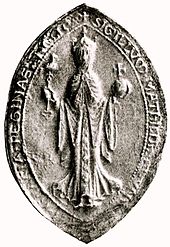One day, he decided to go hunting in the New Forest. This was not unusual. Hunting was a sport of kings, and the New Forest was a great place to do it. Even now it is one of the largest tracts of unenclosed land in England. William's father had declared it a royal forest (today, 90% is still owned by the Crown). William II's older brother Richard had died in the New Forest, colliding with an overhanging branch while riding.
On 2 August 1100, while hunting with companions, he was found with an arrow through his lung. That's all that was recorded. The Anglo-Saxon Chronicle records only that he was "shot by an arrow by one of his own men." Later records report the name of the bowman: Walter Tirel. A generation later, William of Malmesbury offered more detail:
The day before the king died he dreamt that he went to hell and the Devil said to him "I can't wait for tomorrow because we can finally meet in person!" He suddenly awoke. He commanded a light to be brought, and forbade his attendants to leave him. The next day he went into the forest... He was attended by a few persons... Walter Thurold remained with him, while the others were on the chase. The sun was now declining, when the king, drawing his bow and letting fly an arrow, slightly wounded a stag which passed before him... The stag was still running... The king, followed it a long time with his eyes, holding up his hand to keep off the power of the sun's rays. At this instant Walter decided to kill another stag. Oh, gracious God! the arrow pierced the king's breast.
On receiving the wound the king uttered not a word; but breaking off the shaft of the arrow where it projected from his body... This accelerated his death. Walter immediately ran up, but as he found him senseless, he leapt upon his horse, and escaped with the utmost speed. Indeed there were none to pursue him: some helped his flight; others felt sorry for him.
Thurold was another version of the name—Walter Tirel was a real noble connected to the royal family by marriage—and the idea of the king's dream is fantasy. It is true that Tirel fled the scene: having killed the king, his life was forfeit, so he wisely fled to France, where he was sheltered by Abbot Suger, who later confused the issue when he wrote:
It was laid to the charge of a certain noble, Walter Thurold, that he had shot the king with an arrow; but I have often heard him, when he had nothing to fear nor to hope, solemnly swear that on the day in question he was not in the part of the forest where the king was hunting, nor ever saw him in the forest at all.
And supposedly Tirel/Thurold was an excellent marksman, so would he have "accidentally" hit the king? When investigating a crime, the question often asked is cui bono, "to whose good?" Who would benefit from William's death? Also in the hunting party was his younger brother, Henry. With William's death and Robert Curthose off on the First Crusade (he would only return a month after the death), Henry quickly declared himself king.
Did Henry arrange it? He certainly benefited. Did Henry manage to put the blame on Tirel? Who can tell?
Before we leave William Rufus, I want to latch onto one other trivial point about him. Contemporaries noted he was not a particularly nice person, and that his language was "rough." He had a favorite curse, which was "By the Face of Lucca!" What was the "Face of Lucca"? Let's find out next time.












